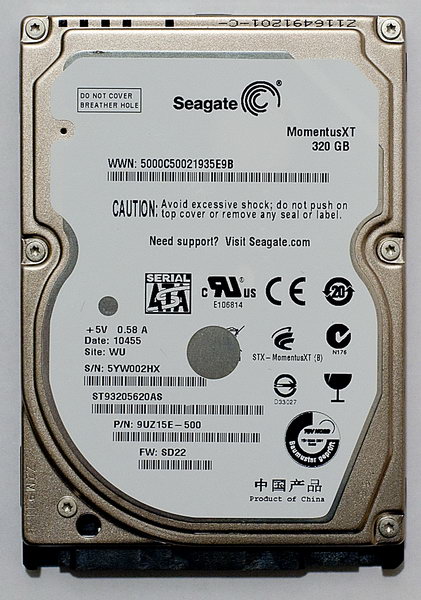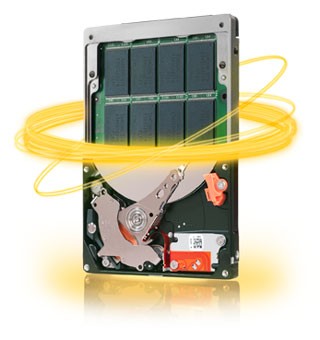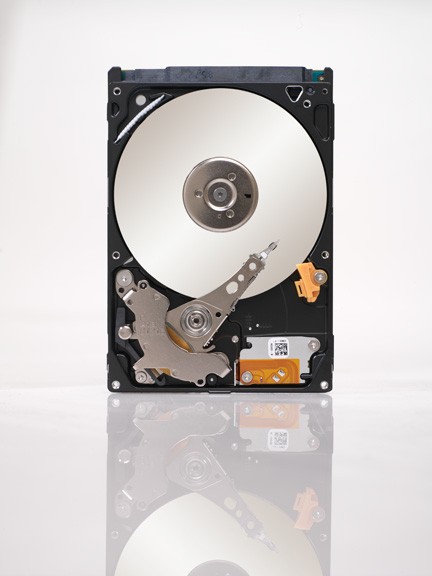Seagate Momentus XT Hybrid Drive: 7,200 rpm and 4 gigabytes of SLC NAND flash memory
Every good, but expensive technology, sooner or later has an alternative, which for much less money offers the same thing. Is it true or not, but the interest in such an alternative always flashes serious - but how can it really be done well and cheaply? Alas, alas, in most cases, “technology” turns out to be a marketing wiring, which, however, does not interfere with applying this approach over and over again, albeit in different forms. In late May, Seagate released a new 2.5-inch Momentus XT drive, which, according to the press release, “combines the performance of solid-state drives, as well as the large capacity and attractive price of traditional hard drives.” Thanks to powerful connections, I managed to get one of the two samples that were currently in Russia for the test.

To get started, let's figure out how this thing works. At the heart of the Momentus XT is a completely ordinary hard drive with a spindle speed of 7200 rpm and a buffer of 32 megabytes. Considering that 5400 rpm and a buffer of 8-16 megs still remain standard for 2.5-inch drives, the drive should be fast enough and "responsive" by itself, without additional tricks.
But the Seagate Momentus XT also has flash memory, thanks to which, according to the company, the drive "works twice as fast as traditional hard drives with a spindle speed of 5400 rpm." Moreover, the memory is not just any, but SLC NAND is the fastest, most reliable and expensive. That fast and reliable is great, but due to the high price, its volume is limited to only four gigabytes. Not much? Well, in general, yes. It would be better eight. Better yet, sixteen. But even four gigs increased the price of the drive by a good 70 bucks, and it’s easy to calculate how much doubling or quadrupling would cost.

Flash remains a “thing in itself”, and you can’t write anything to it on your own. And you don’t see it outside, because for the Momentus XT system it looks like one disk, not two, as was the case with other hybrids. All four gigabytes are managed by Seagate Adaptive Memory technology, which itself, without the help of an operating system, determines the data used most often and transfers it to solid-state memory for faster access. A kind of hardware implementation of ReadyBoost and SuperFetch technologies at the same time. It is worth noting that Adaptive Memory is constantly “learning”, and for the third or fourth time, the application starts faster than the first time. In turn, independence from the operating system allows the disk to work as it should, and under Linux, and under Mac OS, and under any other operating systems.
Such smart hardness, of course, is good, but if you insert a disk into a laptop, you will not confuse it with an SSD if you wish: like all screws with 7200 rpm, the Momentus XT is buzzing with a motor and rattles its heads quite noticeably. No, it won’t blow the sound wave off the chair, but compared to standard laptop screws (standard ones are 5400 rpm) and especially SSD the difference is my respect. It makes no sense to run ordinary tests on Momentus: the data goes directly past the SSD, so you just realize that you are dealing with a good nimble hard drive. For example, here's what Sisoft Sandra 2010 tells us:
Sequential read 87 Mb / s
Random read 59.69 Mb / s
Sequential write 87.13 Mb / s
Random write 60.37 Mb / s
The average access time is 13.21 ms.
Other tests, which have the habit of not storing their files explicitly and erasing them from the test medium, will not feel anything like that either. Well yes, cool screw, what else? To evaluate the effectiveness of the solution, you need to put the operating system and the tests themselves on it. Then, you look, you will feel something.
Firstly, from the third time, the acceleration of loading the operating system is evident. For example, I have a rather littered Vista Ultimate for the first time started in two minutes with a hook, and for the fifth time in just 48 seconds. Feel the difference. The same story with applications: Photoshop CS4 loads for the first time 12 seconds, and the fifth bullets for three seconds. And this, I note, after a complete reboot of the system. IE, Miranda, Word, Outlook, Total Commander, XviD4PSP - just a fly open.

So what? Not cheated, huh? Do not buy SSDs? Well, if you run relatively few programs regularly, then Momentus XT is a good way to save. But if there are thirty of them, and all are heavy enough, the smart Adaptive Memory will run into a lack of space. Throws out old programs, registers new ones, and if you do not run the same Photoshop for a long time, the disk will have to be trained for it again. In general, the contents of flash are rewritten almost continuously for better optimization, but you should not be afraid of this. Firstly, the number of write cycles of the SLC is quite large, not less than 100,000. Secondly, a 5-year warranty is given on the disc, and the death of the flash is a warranty case. Finally, in the third - even if the flash dies, the data will remain intact, because the originals will continue to live on rotating plates.
By the way, even under a good load (five cycles of a file system test in a row) Momentus XT did not warm up above 50 degrees. For comparison, WD Scorpio Blue in the same laptop and under the same conditions reported a temperature of 46 degrees, but it also rotates the spindle more slowly, and inside there is only one plate instead of two for the Momentus XT.
So, with a number of reservations, I can argue that the hybridity in Momentus is quite real and even useful. However, there are two things that I do not like.
The first is a completely user-friendly energy-saving technology. Yes, I understand that a drive needs to mimic under an SSD. But this infection turns off the disk motor after 60 seconds from the last access to the data on the plates. Probably, ideally, everything should be nice and quiet, but in practice after 20-30 seconds the system still remembers the disk, and the spindle begins to spin with a characteristic hum and rattling of the heads. When you listen to such cycles for 20-30 per hour, it is terribly annoying, and changing the interval for turning off the motor is not yet possible. I understand why they did this: the battery needs to be saved, and two controllers, SSD and the actual hard drive, consume energy for both cheeks. But uncomfortable!

The second is the price. A 500GB version of the Seagate Momentus XT will cost about $ 150-160. A Momentus 7200.4 disk of the same size and with the same spindle speed (but, of course, without flash memory) is already for sale today for $ 72-75. Prices for 320 GB versions are $ 130-140 and $ 60-65, respectively (I tested just that). That is, the extra charge for 4 gig of flash is actually double. Is it worth it? Under XP and Vista, it’s probably worth it, because acceleration is evident, and an SSD with similar characteristics is dramatically more expensive. But under Windows 7, with its improved SuperFetch, you hardly feel any difference compared to the “just hard drive” with 7200 rpm. Especially if you are not greedy for a flash drive for ReadyBost. It’s strange to me that software technology turns out to be no worse than hardware technology, but numbers are an elastic thing, and,
The summary is simple: if you like interesting technologies and do not want to spend money on SSDs - Momentus XT is quite an option for tangible system acceleration. Moreover, it costs quite tolerable money, especially when compared with VelociRaptor and Intel's top SSDs. But be aware: imitation can be quite good and satisfy a well-disposed user, but the original, sadly enough for a wallet, is still better.
I wrote a more detailed review of Seagate Momentus XT for 3DNews, if interested, look at it .

To get started, let's figure out how this thing works. At the heart of the Momentus XT is a completely ordinary hard drive with a spindle speed of 7200 rpm and a buffer of 32 megabytes. Considering that 5400 rpm and a buffer of 8-16 megs still remain standard for 2.5-inch drives, the drive should be fast enough and "responsive" by itself, without additional tricks.
But the Seagate Momentus XT also has flash memory, thanks to which, according to the company, the drive "works twice as fast as traditional hard drives with a spindle speed of 5400 rpm." Moreover, the memory is not just any, but SLC NAND is the fastest, most reliable and expensive. That fast and reliable is great, but due to the high price, its volume is limited to only four gigabytes. Not much? Well, in general, yes. It would be better eight. Better yet, sixteen. But even four gigs increased the price of the drive by a good 70 bucks, and it’s easy to calculate how much doubling or quadrupling would cost.

Flash remains a “thing in itself”, and you can’t write anything to it on your own. And you don’t see it outside, because for the Momentus XT system it looks like one disk, not two, as was the case with other hybrids. All four gigabytes are managed by Seagate Adaptive Memory technology, which itself, without the help of an operating system, determines the data used most often and transfers it to solid-state memory for faster access. A kind of hardware implementation of ReadyBoost and SuperFetch technologies at the same time. It is worth noting that Adaptive Memory is constantly “learning”, and for the third or fourth time, the application starts faster than the first time. In turn, independence from the operating system allows the disk to work as it should, and under Linux, and under Mac OS, and under any other operating systems.
Such smart hardness, of course, is good, but if you insert a disk into a laptop, you will not confuse it with an SSD if you wish: like all screws with 7200 rpm, the Momentus XT is buzzing with a motor and rattles its heads quite noticeably. No, it won’t blow the sound wave off the chair, but compared to standard laptop screws (standard ones are 5400 rpm) and especially SSD the difference is my respect. It makes no sense to run ordinary tests on Momentus: the data goes directly past the SSD, so you just realize that you are dealing with a good nimble hard drive. For example, here's what Sisoft Sandra 2010 tells us:
Sequential read 87 Mb / s
Random read 59.69 Mb / s
Sequential write 87.13 Mb / s
Random write 60.37 Mb / s
The average access time is 13.21 ms.
Other tests, which have the habit of not storing their files explicitly and erasing them from the test medium, will not feel anything like that either. Well yes, cool screw, what else? To evaluate the effectiveness of the solution, you need to put the operating system and the tests themselves on it. Then, you look, you will feel something.
Firstly, from the third time, the acceleration of loading the operating system is evident. For example, I have a rather littered Vista Ultimate for the first time started in two minutes with a hook, and for the fifth time in just 48 seconds. Feel the difference. The same story with applications: Photoshop CS4 loads for the first time 12 seconds, and the fifth bullets for three seconds. And this, I note, after a complete reboot of the system. IE, Miranda, Word, Outlook, Total Commander, XviD4PSP - just a fly open.

So what? Not cheated, huh? Do not buy SSDs? Well, if you run relatively few programs regularly, then Momentus XT is a good way to save. But if there are thirty of them, and all are heavy enough, the smart Adaptive Memory will run into a lack of space. Throws out old programs, registers new ones, and if you do not run the same Photoshop for a long time, the disk will have to be trained for it again. In general, the contents of flash are rewritten almost continuously for better optimization, but you should not be afraid of this. Firstly, the number of write cycles of the SLC is quite large, not less than 100,000. Secondly, a 5-year warranty is given on the disc, and the death of the flash is a warranty case. Finally, in the third - even if the flash dies, the data will remain intact, because the originals will continue to live on rotating plates.
By the way, even under a good load (five cycles of a file system test in a row) Momentus XT did not warm up above 50 degrees. For comparison, WD Scorpio Blue in the same laptop and under the same conditions reported a temperature of 46 degrees, but it also rotates the spindle more slowly, and inside there is only one plate instead of two for the Momentus XT.
So, with a number of reservations, I can argue that the hybridity in Momentus is quite real and even useful. However, there are two things that I do not like.
The first is a completely user-friendly energy-saving technology. Yes, I understand that a drive needs to mimic under an SSD. But this infection turns off the disk motor after 60 seconds from the last access to the data on the plates. Probably, ideally, everything should be nice and quiet, but in practice after 20-30 seconds the system still remembers the disk, and the spindle begins to spin with a characteristic hum and rattling of the heads. When you listen to such cycles for 20-30 per hour, it is terribly annoying, and changing the interval for turning off the motor is not yet possible. I understand why they did this: the battery needs to be saved, and two controllers, SSD and the actual hard drive, consume energy for both cheeks. But uncomfortable!

The second is the price. A 500GB version of the Seagate Momentus XT will cost about $ 150-160. A Momentus 7200.4 disk of the same size and with the same spindle speed (but, of course, without flash memory) is already for sale today for $ 72-75. Prices for 320 GB versions are $ 130-140 and $ 60-65, respectively (I tested just that). That is, the extra charge for 4 gig of flash is actually double. Is it worth it? Under XP and Vista, it’s probably worth it, because acceleration is evident, and an SSD with similar characteristics is dramatically more expensive. But under Windows 7, with its improved SuperFetch, you hardly feel any difference compared to the “just hard drive” with 7200 rpm. Especially if you are not greedy for a flash drive for ReadyBost. It’s strange to me that software technology turns out to be no worse than hardware technology, but numbers are an elastic thing, and,
The summary is simple: if you like interesting technologies and do not want to spend money on SSDs - Momentus XT is quite an option for tangible system acceleration. Moreover, it costs quite tolerable money, especially when compared with VelociRaptor and Intel's top SSDs. But be aware: imitation can be quite good and satisfy a well-disposed user, but the original, sadly enough for a wallet, is still better.
I wrote a more detailed review of Seagate Momentus XT for 3DNews, if interested, look at it .
